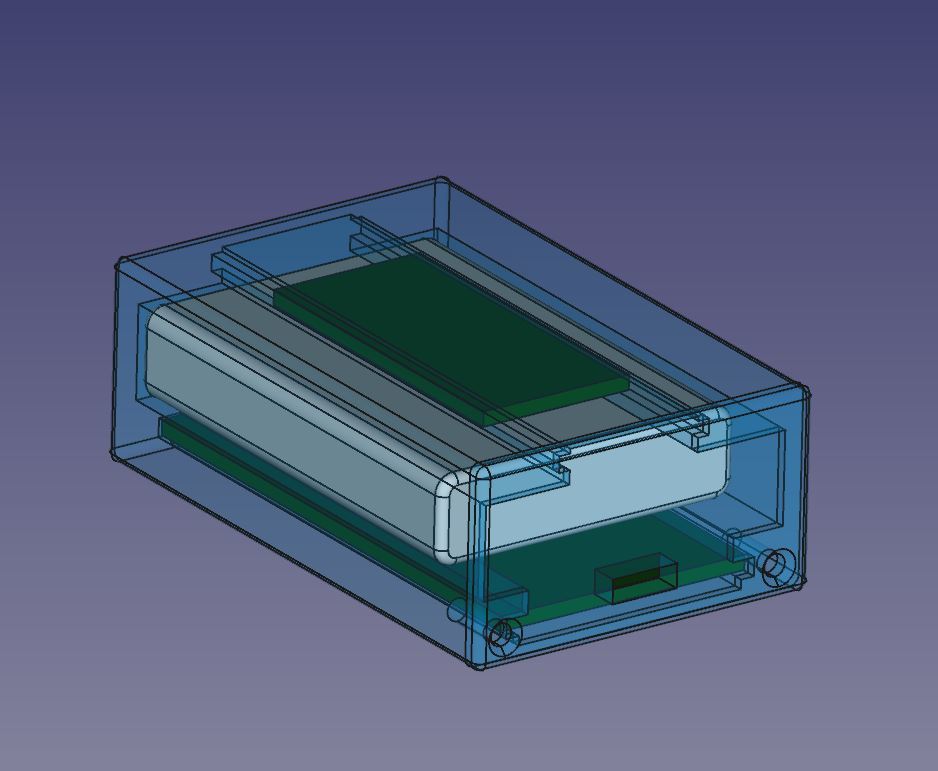
ESP32 + RCWL-0516 + Battery Enclosure
thingiverse
Sensor: The *RCWL-0516 Microwave Radar Sensor* can detect intruders at distances of 5 meters or more. When activated, a signal is sent via the *ESP32* WiFi to a local server where it can be further analyzed if required. Test Units: Three enclosures are included for testing using two different LiPo batteries. The first enclosure uses a $2 creative 680mAh LiPo battery (54x35x4.5mm), which I have several of from an old project, and the second/third enclosures employ an inexpensive Turnigy 2000mAh LiPo battery (50x35x10mm) costing $3. The small battery should easily last one week, and the larger three weeks, as the average standby current is less than 3mA. The smallest enclosure uses a small ESP32 module with micro USB connector for charging the battery, allowing both boards to be mounted side by side greatly reducing the enclosures' size. The sensor enclosure's size is pretty much determined by the capacity of the battery powering it, so it makes more sense to permanently connect units that are located close to mains sockets using an inexpensive usb/phone charger. In an ideal world, a small high-capacity 4-volt battery could power the sensor for six months. Powering the device from a 4.2 volt 2000mAh Battery: The RCWL-0516 is powered directly from the battery, and the ESP32 is powered from the same source via a small diode (to drop the voltage to approximately 3.5 volts). The ESP can safely operate up to 3.6 volts; however, this simple arrangement will ensure the supply never exceeds 3.5 volts (4.2 - 0.7 = ~3.5). In reality, you could charge the LiPo battery to 4.0 volts to reduce the voltage on the ESP to 3.3 volts. The small PCB containing the ESP32 module also includes a micro usb connector to allow for recharging. Added enclosure for a sensor based on one and two 18650 3.2 volt LiFeP04 batteries. The two circuit boards slide into groves (one on each end) allowing a little separation. STL files are last in the list. RCWL-0516's: *15/01/2018* (*last edited: 07/0/2018*) The range of detection was excellent, especially considering it was powered at 3.0 volts (and not the recommended 4 volt as per datasheet). I note there was no noticeable drop off in performance in several days of testing (not bad for a 35¢ device). Powering both devices from a single supply/source: Options: * Two different batteries (LiPo " 4.2 volt for RCWL-0516, LiFePO4 3.2 volt for ESP32) * LDO (drop voltage from LiPo 4.2 volts to 3.3 volts for ESP32) * Buck Converter (boost voltage from LiFePO4 to 4.0 volts to power the RCWL-0516) * Use 1 or 2 diodes from LiPo 4.2 volt to supply the ESP32 (~3.6/~3.0) The diode solution is current and type dependent, and can be problematic; still, I will test it regardless. The LDO is the next best option (lowest extra cost) but there's a 20% increase in current consumption as well as the extra cost and hassle. LiFeP04's arrive: *02/02/2018* The first LiFeP04 batteries arrived several days ago (4 x 1500mAh); the second batch (2 x 1800mAh with build-in protection) arrived yesterday, so I set to work experimenting. While the nominal voltage for PoFePo4 batteries is 3.2V, they can be charged up to 4.2 volts maximum. According to experts, at 4.3 volts the electrolytic will break down and the battery will eventually fail. Note 1: Your battery charger should charge to 3.6 volts maximum to prevent killing your 3.3 volt devices (devices used in this design will operate at 3.6). Note 2: I tested three different chargers, and the resultant charge voltages were; 3.6, 4.0, and 4.2 volts so best make sure your charger doesn't exceed 3.6 volts otherwise you may kill your microprocessor or other devices. Will be moving all parts relating to 3.2 volt to another project. Added enclosure for Sensor and Battery only: 03-04-2018
With this file you will be able to print ESP32 + RCWL-0516 + Battery Enclosure with your 3D printer. Click on the button and save the file on your computer to work, edit or customize your design. You can also find more 3D designs for printers on ESP32 + RCWL-0516 + Battery Enclosure.
